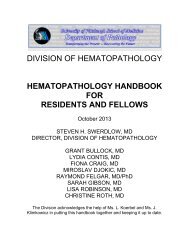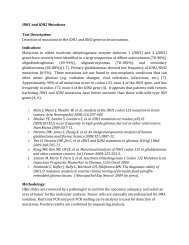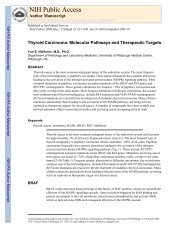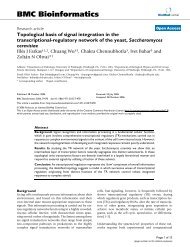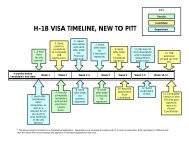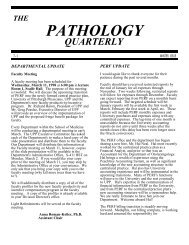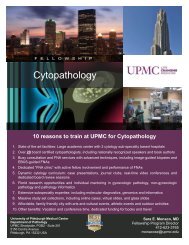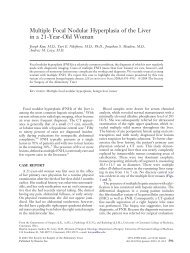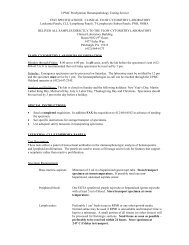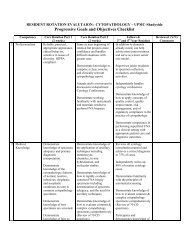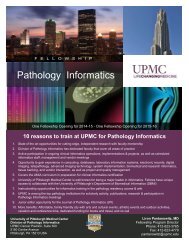Oncogenic AKAP9-BRAF fusion is a novel mechanism of MAPK ...
Oncogenic AKAP9-BRAF fusion is a novel mechanism of MAPK ...
Oncogenic AKAP9-BRAF fusion is a novel mechanism of MAPK ...
Create successful ePaper yourself
Turn your PDF publications into a flip-book with our unique Google optimized e-Paper software.
esearch article<br />
fectamine 2000 (Invitrogen Corp.). After 48 hours, cell extracts were prepared,<br />
immunoprecipitated with mouse anti–myc-IgG (Upstate Cell Signaling<br />
Solutions), and kinase activity determined as directed by the manufacturer<br />
using bacterially purified MEK1 as substrate, and Western blotting with<br />
pMEK1 antibody as a read-out (B-RAF Kinase Assay Kit; Upstate Cell Signaling<br />
Solutions). To determine the effects <strong>of</strong> the <strong>BRAF</strong> mutants on endogenous<br />
ERK1/2 phosphorylation, we incubated pools <strong>of</strong> stably transfected<br />
cells for 12 hours without serum prior to lysate preparation. Lysates were<br />
centrifuged, the supernatant collected, and 100 μg <strong>of</strong> extract subjected to<br />
SDS-PAGE. Proteins were transferred to a nitrocellulose membrane and subject<br />
to Western blot analys<strong>is</strong> with anti–phospho-ERK1/2, anti–total ERK1/2,<br />
or anti-<strong>BRAF</strong> (Santa Cruz Biotechnology Inc.) antibodies.<br />
Transformation assays. For focus assays, NIH3T3 cells were transfected with<br />
empty vector or the indicated <strong>BRAF</strong> and H-RAS expression plasmids using<br />
lip<strong>of</strong>ectamine. After 2 days, cells were split into six 100-mm 3 d<strong>is</strong>hes and incubated<br />
with DMEM containing 5% calf serum for 21 days. Cells were stained<br />
with 0.4% crystal violet and foci counted. For the mouse xenograft experiments,<br />
NIH3T3 cells were cotransfected with pBabe puro and pEFP vector,<br />
pEFP–myc <strong>BRAF</strong> WT , pEFP–<strong>AKAP9</strong>-<strong>BRAF</strong>, pEFP–myc <strong>BRAF</strong> V600E , or pBabe<br />
puro–H-RAS G12V and mass selected by incubation with DMEM containing<br />
5% calf serum and 1 μg/ml puromycin for 3 weeks. A total <strong>of</strong> 10 6 pooled cells<br />
was injected into nude mice. Animals were killed after 2 weeks, and nodules<br />
larger than 5 mm in diameter were scored as positive.<br />
Mutation analys<strong>is</strong>. For the detection <strong>of</strong> <strong>AKAP9</strong>-<strong>BRAF</strong> <strong>fusion</strong>, cDNA amplification<br />
was achieved by PCR using primers located in exon 8 <strong>of</strong> <strong>AKAP9</strong><br />
(Ex8A, 5′-AGCAAGAACAGTTGATTTTGGA-3′) and exon 10 <strong>of</strong> <strong>BRAF</strong><br />
(Ex10B, 5′-GCAGACAAACCTGTGGTTGA-3′), with the expected product<br />
<strong>of</strong> 181 bp. The PCR products were electrophoresed on agarose gels and<br />
bands v<strong>is</strong>ualized by staining with ethidium bromide (frozen t<strong>is</strong>sues) or by<br />
transfer to a nylon filter and hybridization with an internal oligonucleotide<br />
probe (PR, 5′-AAACTTCAGAAAGAACTCAATGTACTT-3′) labeled<br />
with 50 μCi <strong>of</strong> [γ- 32 P]-ATP (paraffin-embedded t<strong>is</strong>sue). Detection <strong>of</strong> V600E<br />
<strong>BRAF</strong> mutation was performed from DNA using real-time PCR and fluorescence<br />
melting curve analys<strong>is</strong>, as previously reported (51), or from cDNA<br />
using real-time RT-PCR with primers 5′-CGACAGACTGCACAGG-3′ and<br />
5′-TGACTTCTGGTGCCAT-3′ and the same probes.<br />
Stat<strong>is</strong>tical analys<strong>is</strong>. The compar<strong>is</strong>on between groups was performed using<br />
a 2-tailed F<strong>is</strong>her exact test. Differences were considered significant when<br />
P was less than 0.05.<br />
Acknowledgments<br />
Th<strong>is</strong> study was supported by NIH grant R01 CA88041 and American<br />
Cancer Society grant RSG-03-027-01-CCE (to Y.E. Nikiforov),<br />
NIH grant R01 CA50706 (to J.A. Fagin), a grant from the American<br />
Cancer Society Ohio Chapter #06001011 (to J.A. Knauf), and a<br />
grant from Deutsche Krebshilfe, Bonn, Germany (to H.M. Rabes).<br />
Collection <strong>of</strong> t<strong>is</strong>sue samples was supported in part by a grant<br />
from the NIH (PHS M01 RR08084) and through the Cooperative<br />
Human T<strong>is</strong>sue Network funded by the National Cancer Institute.<br />
We thank Kenji Fukasawa for γ-tubulin antibody, Mickey Croyle<br />
for technical ass<strong>is</strong>tance, and Richard Mara<strong>is</strong> for the <strong>BRAF</strong> WT and<br />
<strong>BRAF</strong> V600E expression vectors.<br />
Received for publication September 1, 2004, and accepted in<br />
rev<strong>is</strong>ed form October 28, 2004.<br />
Address correspondence to: Yuri Nikiforov, Department <strong>of</strong> Pathology,<br />
University <strong>of</strong> Cincinnati, 231 Albert Sabin Way, PO Box<br />
670529, Cincinnati, Ohio 45267-0529, USA. Phone: (513) 558-<br />
5798; Fax: (513) 558-2289; E-mail: Yuri.Nikiforov@uc.edu.<br />
1. Kimura, E.T., et al. 2003. High prevalence <strong>of</strong> <strong>BRAF</strong><br />
mutations in thyroid cancer: genetic evidence for<br />
constitutive activation <strong>of</strong> the RET/PTC-RAS-<strong>BRAF</strong><br />
signaling pathway in papillary thyroid carcinoma.<br />
Cancer Res. 63:1454–1457.<br />
2. Soares, P., et al. 2003. <strong>BRAF</strong> mutations and RET/<br />
PTC rearrangements are alternative events in the<br />
etiopathogenes<strong>is</strong> <strong>of</strong> PTC. Oncogene. 22:4578–4580.<br />
3. Frattini, M., et al. 2004. Alternative mutations <strong>of</strong><br />
<strong>BRAF</strong>, RET and NTRK1 are associated with similar<br />
but d<strong>is</strong>tinct gene expression patterns in papillary<br />
thyroid cancer. Oncogene. 23:7436–7440.<br />
4. Takahashi, M., Ritz, J., and Cooper, G.M. 1985.<br />
Activation <strong>of</strong> a <strong>novel</strong> human transforming gene,<br />
ret, by DNA rearrangement. Cell. 42:581–588.<br />
5. Takahashi, M. 1988. Structure and expression<br />
<strong>of</strong> the ret transforming gene. IARC Sci. Publ.<br />
1988:189–197.<br />
6. Fusco, A., et al. 1987. A new oncogene in human<br />
thyroid papillary carcinomas and their lymphnodal<br />
metastases. Nature. 328:170–172.<br />
7. Grieco, M., et al. 1990. PTC <strong>is</strong> a <strong>novel</strong> rearranged<br />
form <strong>of</strong> the ret proto-oncogene and <strong>is</strong> frequently<br />
detected in vivo in human thyroid papillary carcinomas.<br />
Cell. 60:557–563.<br />
8. Pierotti, M.A., et al. 1992. Characterization <strong>of</strong> an<br />
inversion on the long arm <strong>of</strong> chromosome 10 juxtaposing<br />
D10S170 and RET and creating the oncogenic<br />
sequence RET/PTC. Proc. Natl. Acad. Sci. U. S. A.<br />
89:1616–1620.<br />
9. Minoletti, F., et al. 1994. The two genes generating<br />
RET/PTC3 are localized in chromosomal band<br />
10q11.2. Genes Chromosomes Cancer. 11:51–57.<br />
10. Asai, N., Murakami, H., Iwashita, T., and Takahashi,<br />
M. 1996. A mutation at tyrosine 1062 in<br />
MEN2A-Ret and MEN2B-Ret impairs their transforming<br />
activity and association with shc adaptor<br />
proteins. J. Biol. Chem. 271:17644–17649.<br />
11. Knauf, J.A., Kuroda, H., Basu, S., and Fagin, J.A.<br />
2003. RET/PTC-induced dedifferentiation <strong>of</strong><br />
thyroid cells <strong>is</strong> mediated through Y1062 signaling<br />
through SHC-RAS-MAP kinase. Oncogene.<br />
22:4406–4412.<br />
12. Zhu, Z., Gandhi, M., Nikiforova, M.N., F<strong>is</strong>cher,<br />
A.H., and Nikiforov, Y.E. 2003. Molecular pr<strong>of</strong>ile<br />
and clinical-pathologic features <strong>of</strong> the follicular<br />
variant <strong>of</strong> papillary thyroid carcinoma. An unusually<br />
high prevalence <strong>of</strong> ras mutations. Am. J. Clin.<br />
Pathol. 120:71–77.<br />
13. Cohen, Y., et al. 2003. <strong>BRAF</strong> mutation in papillary<br />
thyroid carcinoma. J. Natl. Cancer Inst. 95:625–627.<br />
14. Davies, H., et al. 2002. Mutations <strong>of</strong> the <strong>BRAF</strong> gene<br />
in human cancer. Nature. 417:949–954.<br />
15. Wan, P.T., et al. 2004. Mechan<strong>is</strong>m <strong>of</strong> activation<br />
<strong>of</strong> the RAF-ERK signaling pathway by oncogenic<br />
mutations <strong>of</strong> B-RAF. Cell. 116:855–867.<br />
16. Ikawa, S., et al. 1988. B-raf, a new member <strong>of</strong> the<br />
raf family, <strong>is</strong> activated by DNA rearrangement. Mol.<br />
Cell. Biol. 8:2651–2654.<br />
17. Miki, T., et al. 1991. Development <strong>of</strong> a highly efficient<br />
expression cDNA cloning system: application<br />
to oncogene <strong>is</strong>olation. Proc. Natl. Acad. Sci. U. S. A.<br />
88:5167–5171.<br />
18. Eychene, A., Barnier, J.V., Apiou, F., Dutrillaux, B.,<br />
and Calothy, G. 1992. Chromosomal assignment<br />
<strong>of</strong> two human B-raf(Rmil) proto-oncogene loci:<br />
B-raf-1 encoding the p94Braf/Rmil and B-raf-2, a<br />
processed pseudogene. Oncogene. 7:1657–1660.<br />
19. Witczak, O., et al. 1999. Cloning and characterization<br />
<strong>of</strong> a cDNA encoding an A-kinase anchoring<br />
protein located in the centrosome, AKAP450.<br />
EMBO J. 18:1858–1868.<br />
20. Takahashi, M., et al. 1999. Characterization <strong>of</strong> a <strong>novel</strong><br />
giant scaffolding protein, CG-NAP, that anchors<br />
multiple signaling enzymes to centrosome and the<br />
golgi apparatus. J. Biol. Chem. 274:17267–17274.<br />
21. Schmidt, P.H., et al. 1999. AKAP350, a multiply<br />
spliced protein kinase A-anchoring protein associated<br />
with centrosomes. J. Biol. Chem. 274:3055–3066.<br />
22. Gillingham, A.K., and Munro, S. 2000. The PACT<br />
domain, a conserved centrosomal targeting motif<br />
in the coiled-coil proteins AKAP450 and pericentrin.<br />
EMBO Rep. 1:524–529.<br />
23. Takahashi, M., Yamagiwa, A., N<strong>is</strong>himura, T.,<br />
Mukai, H., and Ono, Y. 2002. Centrosomal proteins<br />
CG-NAP and kendrin provide microtubule<br />
nucleation sites by anchoring gamma-tubulin ring<br />
complex. Mol. Biol. Cell. 13:3235–3245.<br />
24. Sithanandam, G., Kolch, W., Duh, F.M., and<br />
Rapp, U.R. 1990. Complete coding sequence<br />
<strong>of</strong> a human B-raf cDNA and detection <strong>of</strong> B-raf<br />
protein kinase with <strong>is</strong>ozyme specific antibodies.<br />
Oncogene. 5:1775–1780.<br />
25. Avruch, J., et al. 2001. Ras activation <strong>of</strong> the Raf<br />
kinase: tyrosine kinase recruitment <strong>of</strong> the MAP<br />
kinase cascade. Recent Prog. Horm. Res. 56:127–155.<br />
26. Brose, M.S., et al. 2002. <strong>BRAF</strong> and RAS mutations<br />
in human lung cancer and melanoma. Cancer Res.<br />
62:6997–7000.<br />
27. Rajagopalan, H., et al. 2002. Tumorigenes<strong>is</strong>:<br />
RAF/RAS oncogenes and m<strong>is</strong>match-repair status.<br />
Nature. 418:934.<br />
28. Xu, X., Quiros, R.M., Gattuso, P., Ain, K.B., and<br />
Prinz, R.A. 2003. High prevalence <strong>of</strong> <strong>BRAF</strong> gene<br />
mutation in papillary thyroid carcinomas and thyroid<br />
tumor cell lines. Cancer Res. 63:4561–4567.<br />
29. Edwards, A.S., and Scott, J.D. 2000. A-kinase<br />
anchoring proteins: protein kinase A and beyond.<br />
Curr. Opin. Cell Biol. 12:217–221.<br />
30. Takahashi, M., Mukai, H., O<strong>is</strong>hi, K., Isagawa,<br />
T., and Ono, Y. 2000. Association <strong>of</strong> immature<br />
hypophosphorylated protein kinase cepsilon<br />
with an anchoring protein CG-NAP. J. Biol. Chem.<br />
275:34592–34596.<br />
100 The Journal <strong>of</strong> Clinical Investigation http://www.jci.org Volume 115 Number 1 January 2005



